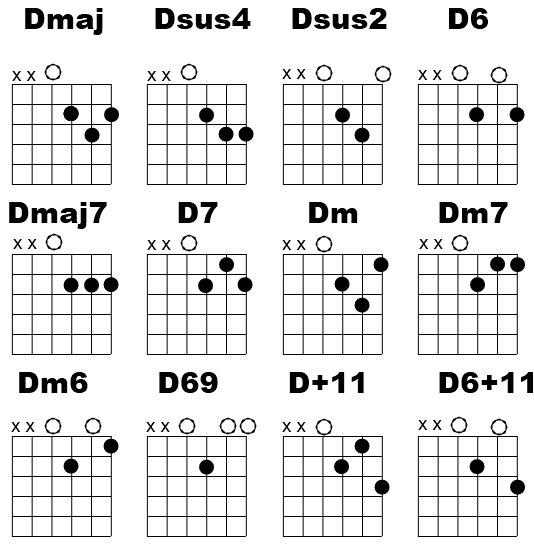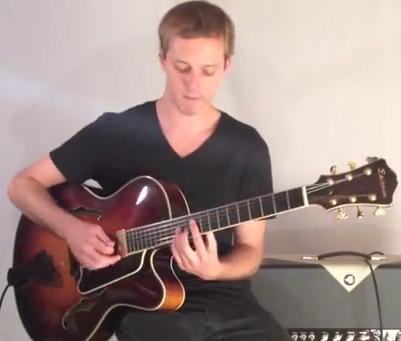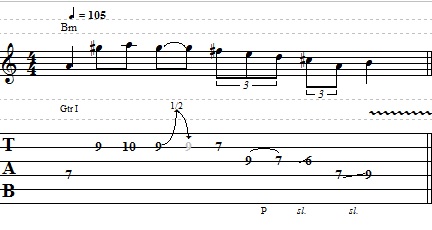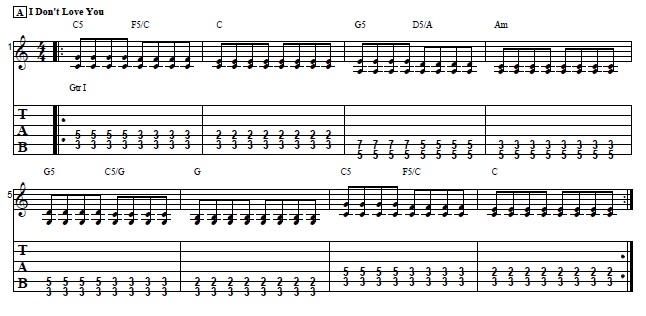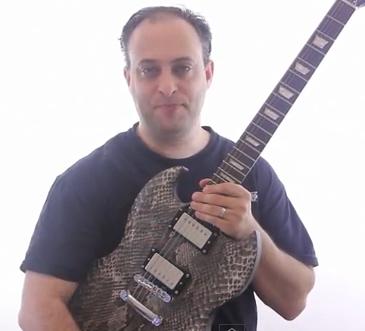Hey, guys Claude Johnson with Guitar Control, I want to show you guys some cool D chord variations. Some of these you probably know and some of them are going to be new. So let’s just jump right into it.
Here´s a cool guitar lesson about D chord variations!
Hope it helps…
We’re going to start with just a basic D chord. For you newbies out there, you’re just going to put your ring finger on the 3rd fret of the B string, middle finger on the 2nd fret of the high E-string, and then first finger on the 2nd fret of the G-string. Then you play the top four strings.
Now it’s also important to understand which notes are in which positions. So your open D-string is a D, obviously. Then you have an A, which is the 5th
degree. Then you have your root again, that’s your octave D and then your F sharp is your 3rd. So you would spell that D, F sharp, A.
Now what you can do from here, and a lot of you guys know this one, you put your pinky on the high E-string 3rd fret. So you’re moving this F sharp up to a G. That chord is called D sus 4. Here’s another variation, again, if you know that one you probably know this next one. You just lift-off. So this finger, middle finger, playing the F sharp, you just lift it off for the open E. So that’s called a D sus 2.
These are really common chords, the D sus 4 and the D sus 2. You could do this… Kind of like Tom Petty, “Free Fallin”. stuff like that. It’s in lots of rock songs.
What else can we do from here? Well, let’s try lifting-off this finger, the B string. That gives us a D 6. Just going back to our theory, how do we get the 6th? Well, right now our finger is on the root or the octave. There’s our D. So count up six notes of the scale; it’s a B. So instead of D, we’ll just play the B. That give us root, 5th, 6th and 3rd. It has a real nice open quality, nice open
sound to it.
Now here’s another one. What if I just bar the top three fingers. When I say bar that means using one finger to hold down several strings. I’m going
to still play the open D-string, but then the top three strings are going to be all the 2nd fret and all with the first finger here. It’s a beautiful D major 7.
Here’s another one you might know, D7. So here, now I’ve got my middle finger up on the G-string 2nd fret, ring finger — so I’ve kind of switched where my fingers are going here. Ring finger on the high E-string 2nd fret and then my 1st string finger goes here on the 1st fret of the B-string. So this note here is the C, which is the 7th degree. So one nice thing you can do is go from your D to a D major 7 and then to a D7. It gives you like a Beatles
kind of sound, right? You can go different places from there.
What about D minor? Here’s your basic D minor chord. I’ve got my middle finger on the D, which is on the 3rd fret of the B-string and then I’ve got my middle finger on the 2nd fret of the G-string, my first finger up here on the
1st fret of the high E-string. Here’s my F, which is the minor 3rd. Well, we can change that into a D minor 7 by barring the top two, like this. We’ve still got our middle finger here on the 2nd fret of the G-string. All these chords are still using the open D-string as well. You have D minor, D minor 7.
We could also do this, D minor 6 with the open B-string. So this one is just like a D minor but I’m lifting off of the B-string. We could also lift off this and lift off the high E-string. So you’re only really fretting one note here, on the A, with your open D, A, open B, open E. That’s like a D 6-9 chord. Then you can also get some chords by putting your third finger on the G note here. So we already saw this one. That’s the D sus 4 where we’ve got our D on the B-string. What if we’d move that D down to a C so we have this. This one I’ve got my middle finger on the A 2nd fret G-string; first finger on the C, 7th degree; and then ring finger on the high G on the 3rd fret of the E- string. hat would be like a D note 3rd add 11, you could call it that. Here’s one more variation, some chord, but lift off of the B string. That would be like a D6 no 3rd add 11.
With any of these chords you can also play the low A-string which, again, the A is the 5th degree. So it would be like a D/A or A and a bass. So a normal D would sound like this… The A on the bass… And then you could also put your thumb here on the low F sharp. It gives you a D/F sharp. Van Halen used this like on… That’s in that song “Best of Both Worlds”, which I’ll probably go over another day. Anyway, there’s a lot of cool variations for you. Play around with it.
Make sure to subscribe on our You Tube Channel and we’ll see you in our next video lessons, thanks for watching.
Beginner Guitar Lesson – How to Play D Chord
Variations – Easy Guitar Chords
There’s more chords I didn’t have time to write… For example, see if you can find the open position patterns for D major 9 and D9!
CLICK HERE FOR THE ULTIMATE BEGINNER GUITAR COURSE
